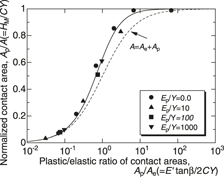Article contents
Contact-area-based FEA study on conical indentation problems for elastoplastic and viscoelastic-plastic bodies
Published online by Cambridge University Press: 17 November 2011
Abstract

The authors discuss the contact-area-based indentation contact mechanics instead of the conventional penetration-depth-based analysis. In time-independent elastoplastic regime, the indentation load P versus contact area A relationship for a cone indentation is linear both for the loading and the unloading paths. The slope of the loading path directly yields the Meyer hardness HM, and the slope of the unloading path, i.e., the unloading modulus M, is related to the elastic modulus E′ through the relation of M = E′tan β/2. The relation of the total contact area A to the purely elastic and the purely plastic contact areas of Ae and Ap are theoretically as well as numerically examined. The normalized relationship between Ap/A versus Ap/Ae is equivalent to the Johnson’s hardness plot of HM/Y versus E′tan β/Y. By extending the concept of Ae and Ap to time-dependent viscoelastic-plastic regime, a detailed discussion is made how to eliminate the plastic deformation/flow from the total contact area A(t) to yield the viscoelastic contact area Ave(t) prior to determining the linear-viscoelastic parameters and functions.
- Type
- Articles
- Information
- Journal of Materials Research , Volume 27 , Issue 1: Focus Issue: Instrumented Indentation , 14 January 2012 , pp. 256 - 265
- Copyright
- Copyright © Materials Research Society 2011
References
REFERENCES
- 2
- Cited by




